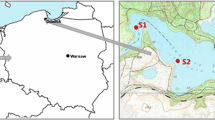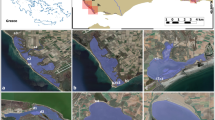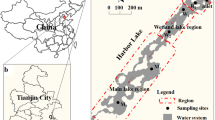Abstract
To examine the status and risk of heavy metal pollution, the distribution of As, Cd, Cr, Ni, and Pb in the sediment of Lake Uluabat was characterized. The present study used a four-stage method to assess the ecotoxicological effects of the heavy metal and trace elements fractions in the sediment of Lake Uluabat. Total Cr and Ni concentrations in the sediment were determined to have exceeded the severe effect level (SEL) limit values. The percentages of the variable fractions of Cr and Ni were below 10%. Because of this reason, they were not defined to have a high risk. The relationships among the physicochemical parameters, heavy metals and trace elements in water and sediment were determined statistically. Pb, Cd, and As in the water were found in relation with some of the fractions. Moreover, it was thought that the amounts of the elements of As releasing into the water might be increased due to their relations with the physicochemical parameters.




Similar content being viewed by others

References
Aksoy, E., & Ozsoy, G. (2002). Investigation of multi-temporal land use/cover and shoreline changes of the Uluabat Lake Ramsar site using RS and GIS. Çanakkale, Turkey: The International Conference on Sustainable Land Use and Management.
Alonso Castillo, M.L., Vereda Alonso, E., Siles Cordero, M.T., Cano Pavón, J.M. & García de Torres, A. (2011). Fractionation of heavy metals in sediment by using microwave assisted sequential extraction procedure and determination by inductively coupled plasma mass spectrometry. Microchemical Journal, Article in Press.
APHA, AWWA (1998). Standard methods for the examination of water and wastewater. 20th Edition. Washington, D.C.
Arain, M. B., Kazi, T. G., Jamali, M. K., Jalbani, N., Afridi, H. I., & Shah, A. (2008). Total dissolved and bioavailable elements in water and sediment samples and their accumulation in Oreochromis mossambicus of polluted Manchar Lake. Chemosphere, 70, 1845–1856.
Aydınalp, C., Fıtzpatrıck, E. A., & Cresser, M. S. (2005). Heavy metal pollution in some soil and water resources of Bursa Province, Turkey. Communications in Soil Science and Plant Analysis, 36, 1691–1716.
Barlas, N., Akbulut, N., & Aydoğan, M. (2005). Assessment of heavy metal residues in the sediment and water samples of Uluabat Lake, Turkey. Bulletin of Environmental Contamination and Toxicology, 74, 286–293.
Başar, H., Gürel, S., & Katkat, A. V. (2004). Contents of heavy metals in the Lake İznik Basin soils irrigated with various water resources (in Turkish). Journal of Agricultural Faculty of Uludağ University, 18(1), 93–104.
Bouyoucos, G. J. (1951). A recalibration of the hydrometer method for making mechanical analysis of soil. Agronomy Journal, 43, 434–438.
Bradl, H.B. (2005). Heavy metals in the environment: origin, interaction and remediation, p: 269. Elsevier.
Burton, G.A. & Pitt, R.E. (2002). Storm water, effects handbook. Lewis, CRC. 929 p.
Dalkıran, N., Karacaoğlu, D., Dere, S., Sentürk, E., & Torunoğlu, T. (2006). Factors affecting the current status of a eutrophic shallow lake (Lake Uluabat, Turkey): Relationships between Water Physical and Chemical Variables. Chemistry and Ecology, 22(4), 279–298.
Elmacı, A., Teksoy, A., Topac, F. O., Özengin, N., Kurtoğlu, S., & Başkaya, H. S. (2007). Assessment of heavy metals in Lake Uluabat, Turkey. African Journal of Biotechnology, 6(19), 2236–2244.
Farkas, A., Erratico, C., & Vigano, L. (2007). Assessment of the environmental significance of heavy metal pollution in surficial sediments of The River Po. Chemosphere, 68, 761–768.
Fytianos, K., & Lourantou, A. (2004). Speciation of elements in sediment samples collected at lakes Volvi and Koronia, N. Greece. Environment International, 30, 11–17.
Guo, S., Wang, X., Yu, L., Chen, J.-J., & Yang, J.-C. (2006). Investigation on Fe, Mn, Zn, Cu, Pb and Cd fractions in the natural surface coating samples and surficial sediments in The Songhua River, China. Journal of Environmental Sciences, 18(6), 1193–1198.
Güven, D., & Akıncı, G. (2008). Heavy metals partitioning in the sediments of Izmir Inner Bay. Journal of Environmental Sciences, 20, 413–418.
Harikumar, P. S., & Nasir, U. P. (2010). Ecotoxicological impact assessment of heavy metals in core sediments of a tropical estuary. Ecotoxicology and Environmental Safety, 73, 1742–1747.
Ikem, A., & Adisa, S. (2011). Runoff effect on eutrophic lake water quality and heavy metal distribution in recent littoral sediment. Chemosphere, 82, 259–267.
Inc, M. (2007). Meet Minitab, Release 15 for Windows. USA: State College.
Itoh, A., Nagasawa, T., Zhu, Y., Lee, K. H., Fujimori, E., & Haraguchi, H. (2004). Distributions of major-to-ultra trace elements among the particulate and dissolved fractions in natural water as studied by ICP-AES and ICP-MS after sequential fractionation. Analytical Sciences, 20, 29–36.
Kamala-Kannan, S., Batvaru, B., Lee, K. J., Kannan, N., Krishnamoorthy, R., Shanthi, K., et al. (2008). Assessment of heavy metals (Cd, Cr and Pb) in water, sediment and seaweed (Ulva lactuca) in the Pulicat Lake, South East India. Chemosphere, 71, 1233–1240.
Karaer, F., & Küçükballı, A. (2006). Monitoring of water quality and assessment of organic pollution load in the Nilüfer Stream, Turkey. Environmental Monitoring and Assessment, 114, 391–417.
Karaer, F., Katip, A., Aksoy, E., İleri, S. & Sarmaşık, S. (2009). The importance of wetlands, problems and Lake Uluabat, Turkey. Wetlands Conference, 22–23 May (in Turkish). Eskikaraağaç, Bursa, p: 81–87.
Katip, A. (2010). Water quality monitoring of Lake Uluabat. PhD Thesis (in Turkish). Uludağ University, Uludağ University, Graduate School of Natural and Applied Sciences, Department of Environmental Engineering, Bursa.
Kazancı, N., Toprak, Ö., Leroy, S. A. G., Öncel, S., Ileri, Ö., Emre, Ö., et al. (2006). Boron content of Lake Uluabat sediment: A key to interpret the morphological history of NW Anatolia, Turkey. Applied Geochemistry, 21, 234–251.
Kazancı, N., Leroy, S. A. G., Öncel, S., Ileri, O., Toprak, O., Costa, P., et al. (2010). Wind control on the accumulation of heavy metals in sediment of Lake Ulubat, Anatolia, Turkey. Journal of Paleolimnology, 43, 89–110.
Linge, K. L., & Oldham, C. E. (2004). Control mechanisms for dissolved phosphorus and arsenic in a shallow lake. Applied Geochemistry, 19(9), 1377–1389.
Liu, H., Li, L., Yin, C., & Shan, B. (2008). Fraction distribution and risk assessment of heavy metals in sediments of Moshui Lake. Journal of Environmental Sciences, 20, 390–397.
Maanan, M., Zourarah, B., Carruesco, C., Aajjane, A., & Naud, J. (2004). The distribution of heavy metals in the Sidi Moussa lagoon sediments (Atlantic Moroccan Coast). Journal of African Earth Sciences, 39, 473–483.
Mendil, D., & Uluözlü, O. D. (2007). Determination of trace metal levels in sediment and five fish species from lakes in Tokat, Turkey. Food Chemistry, 101, 739–745.
Mingbiao, L., Jianqiang, L., Weipeng, C., & Maolan, W. (2008). Study of heavy metal speciation in branch sediments of Poyang Lake. Journal of Environmental Sciences, 20, 161–166.
Mingkui, Z., & Hao, W. (2009). Concentrations and chemical forms of potentially toxic metals in road-deposited sediments from different zones of Hangzhou, China. Journal of Environmental Sciences, 21, 625–631.
Nelson, R. E. (1982). Carbonate and gypsum. Methods of soil analysis, Part 2. Chemical and microbiological properties (pp. 181–196). USA: American Soc. Ag. Inc. Pub. Agronomy Series, No.9.
Nguyen, H. L., Leermakers, M., Osán, J., Török, S., & Baeyens, W. (2005). Heavy metals in Lake Balaton: water column, suspended matter, sediment and biota. Science of the Total Environment, 340(1–3), 213–230.
Nyamangara, J. (1998). Use of sequential extraction to evaluate zinc and copper in a soil amended with sewage sludge and inorganic metal salts. Agriculture, Ecosystems and Environment, 69, 135–141.
Radojevic, M., & Bashkin, V. N. (1999). Practical environmental analysis (pp. 313–315). UK: The Royal Society of Chemistry, Cambridge. 325–330.
Ren-Ying, L., Hao, Y., Zhi-Gao, Z., Jun-Jie, L., Xiao-Hua, S., & Feng, J. (2007). Fractionation of heavy metals in sediments from Dianchi Lake, China. Pedosphere, 17(2), 265–272.
Rodgher, S., & Espíndola, E. L. G. (2008). Effects of interactions between algal densities and cadmium concentrations on Ceriodaphnia dubia fecundity and survival. Ecotoxicology and Environmental Safety, 71, 765–773.
Salihoğlu, G., & Karaer, F. (2004). Ecological risk assessment and problem formulation for Lake Uluabat, a ramsar state in Turkey. Environmental Management, 33, 899–910.
Sharmin, S., Zakir, H. M., & Shikazono, N. (2010). Fractionation profile and mobility pattern of trace metals in sediments of Nomi River, Tokyo, Japan. Journal of Soil Science and Environmental Management, 1(1), 001–014.
Shu-hai, G., Xiao-li, W., Yu, L., Jie-jiang, C., & Jun-cheng, Y. (2006). Investigation on Fe, Mn, Zn, Cu, Pb and Cd fractions in the natural surface coating samples and suflicial sediments in the Songhua River, China. Journal of Environmental Sciences, 18(6), 1193–1198.
Singh, A. P., Srivastava, P. C., & Srivastava, P. (2008). Relationships of heavy metals in natural lake waters with physico-chemical characteristics of waters and different chemical fractions of metals in sediments. Water, Air, and Soil Pollution, 188, 181–193.
Soil Survey Staff (1962). Soil Survey Manual (p.503). USDA Handbook No:18, Washington.
Stumm, W., & Morgan, J. (1996). Aquatic chemistry: An introduction emphasizing chemical equilibria in natural water (3rd ed.). New York: Wiley.
Taşdemir, Y., Kural, C., Cindoruk, S., & Vardar, N. (2006). Assessment of trace element concentrations and their estimated dry deposition fluxes in an urban atmosphere. Atmospheric Research, 81, 17–35.
Tokalioğlu, Ş., Kartal, Ş., & Elçi, L. (2000). Determination of heavy metals and their speciation in lake sediments by flame atomic absorption spectrometry after a four-stage sequential extraction procedure. Analytica Chimica Acta, 413, 33–40.
USEPA (2000). Prediction of sediment toxicity using consensus-based freshwater sediment quality guidelines.
USEPA (2006). National recommended water quality criteria correction office of water. 822-z-99-001, p. 25.
Uysal, K., Köse, E., Bülbül, M., Dönmez, M., Erdoğan, Y., Koyun, M., et al. (2009). The comparison of heavy metal accumulation ratios of some fish species in Enne Dame Lake (Kütahya/Turkey). Environmental Monitoring and Assessment, 157, 355–362.
Vicente-Martorell, J. J., Galindo-Riano, M. D., García-Vargas, M., & Granado-Castro, M. D. (2009). Bioavailability of heavy metals monitoring water, sediments and fish species from a polluted estuary. Journal of Hazardous Materials, 162, 823–836.
Volkenborn, N., Hedtkamp, S. I. C., Van Beusekom, J. E. E., & Reise, K. (2007). Effects of bioturbation and bioirrigation by Lugworms (Arenicola marina) on physical and chemical sediment properties and implications for intertidal habitat succession. Estuarine, Coastal and Shelf Science, 74, 331–343.
WHO (2006). A compendium of drinking-water quality standards in the Eastern Mediterranean Region.
Yang, Z., Wang, Y., Shen, Z., Niu, J., & Tang, Z. (2009). Distribution and speciation of heavy metals in sediments from the mainstream, tributaries, and lakes of the Yangtze River catchment ofWuhan, China. Journal of Hazardous Materials, 166, 1186–1194.
Ying, X. & Jing-Ling, L. (2010). Study on form distribution and correlation of heavy metals in the sediment of urban water. International Conference Bioinformatics and Biomedical Engineering (iCBBE), 18–20 June. Chengdu, China.
Yuan, C. G., Shi, J. B., He, B., Liu, J. F., Liang, L. N., & Jiang, G. B. (2004). Speciation of heavy metals in marine sediments from the East China Sea by ICP-MS with sequential extraction. Environment International, 30, 769–783.
Zeien, H., & Brümmer, G. W. (1989). Chemische extraktionen zur bestimmung von schwermetallbindungs formen in böden. Mitteilgn Dtsch Badenkundl Gesellsch, 59, 505–510.
Acknowledgments
The project was funded by the Environment, Atmosphere, Earth and Marine Sciences group (ÇAYDAG) (project no: 107Y278) of the Scientific and Technical Research Council of Turkey (TÜBİTAK) and Scientific Research Foundation (Project no: M-2007/27) of Uludağ University.
Author information
Authors and Affiliations
Corresponding author
Rights and permissions
About this article
Cite this article
Katip, A., Karaer, F., Başkaya, H.S. et al. Fraction distribution and risk assessment of heavy metals and trace elements in sediments of Lake Uluabat. Environ Monit Assess 184, 5399–5413 (2012). https://doi.org/10.1007/s10661-011-2348-4
Received:
Accepted:
Published:
Issue Date:
DOI: https://doi.org/10.1007/s10661-011-2348-4



